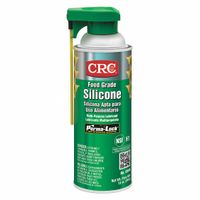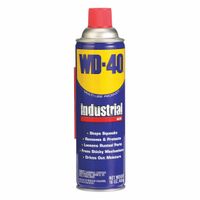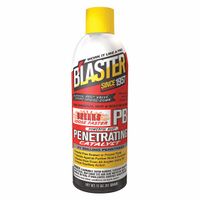Call +(254) 703 030 000 / 751 483 999 / 721 704 777
- Home
- Lubrication
- Lubricants Penetrating Lubricants
.....Read More
Frequently Asked Questions
What is the difference between lubricants and penetrating lubricants?
Please provide a specific topic for which you would like an elaborate answer.
How do lubricants reduce friction and wear on machinery?
Lubricants reduce friction and wear on machinery primarily by creating a thin film that separates moving surfaces. This film, often oil or grease, prevents direct metal-to-metal contact, which is the root cause of friction and wear.
When surfaces rub together, microscopic asperities (roughness) on their surfaces interlock, leading to resistance and material removal. Lubricants work in several ways to mitigate this:1. **Fluid Film Lubrication:** In this mode, the lubricant forms a thick enough layer to completely separate the moving parts. This can be hydrodynamic (pressure generated by relative motion) or hydrostatic (external pressure applied). The fluid film carries the load, significantly reducing friction and preventing wear.
2. **Boundary Lubrication:** When the fluid film is too thin (e.g., at high loads or low speeds), some metal-to-metal contact can occur. In such cases, special additives in the lubricant form protective chemical layers on the metal surfaces. These layers are sacrificial and prevent severe damage, acting as a last line of defense against wear.
3. **Reducing Heat:** Friction generates heat. Lubricants absorb and dissipate this heat, preventing thermal expansion and potential seizing of components.
4. **Corrosion Protection:** Many lubricants contain additives that protect metal surfaces from rust and corrosion, extending the lifespan of machinery.
5. **Contaminant Suspension:** Lubricants can suspend and carry away contaminants like dirt, debris, and wear particles, preventing them from causing further damage.By performing these functions, lubricants ensure smooth operation, extend the life of machinery, improve energy efficiency, and reduce maintenance costs.
What are the benefits of using dry lubricants?
Dry lubricants offer several advantages over traditional wet lubricants, particularly in specific applications. One primary benefit is their ability to operate effectively in extreme conditions, such as high temperatures, vacuums, or environments where liquid lubricants would evaporate, degrade, or become contaminated. They create a solid, protective film that reduces friction and wear without attracting dust or debris, which is a common issue with wet lubricants. This makes them ideal for use in clean rooms, sensitive electronics, and machinery where cleanliness is paramount. Additionally, dry lubricants are often more environmentally friendly, as they typically contain fewer volatile organic compounds (VOCs) and can be applied in thinner layers, reducing waste. They also eliminate the mess and potential for leakage associated with oils and greases, simplifying maintenance and improving operational safety.
How do penetrating lubricants work to loosen stuck fasteners?
Penetrating lubricants work by utilizing a combination of low viscosity, surface tension, and capillary action to infiltrate tight spaces and rusted or seized connections. Their low viscosity allows them to flow into minute gaps that thicker oils or greases cannot access. Once applied, the lubricant's low surface tension enables it to spread out across the metal surface, effectively "wetting" it and reducing the adhesive forces between the stuck components.
The most crucial mechanism is capillary action. This is the ability of a liquid to flow in narrow spaces without the assistance of, or even in opposition to, external forces like gravity. As the lubricant encounters the microscopic crevices and pores within a rusted or corroded joint, the capillary forces draw it deeper into the interface between the stuck parts. This action allows the lubricant to reach areas that would otherwise be inaccessible.
Upon reaching these areas, the lubricant can perform several functions. It can dissolve or break down rust and corrosion by chemically reacting with the oxides, making them less tenacious. It also provides a slippery film that reduces friction between the mating surfaces, allowing them to move more freely. Some penetrating lubricants also contain additives that help to displace moisture, further aiding in the release of seized parts. The combined effect of these properties allows the lubricant to "creep" into the tightest spots, lubricating and breaking down the bonds that are causing the fasteners to stick, ultimately making them easier to loosen.
What are the best applications for dry lubricants?
Dry lubricants are highly effective in applications where traditional wet lubricants (oils or greases) would be impractical or detrimental. They are particularly valuable in environments where cleanliness is paramount, such as in food processing or cleanrooms, as they do not attract dust or debris. High-temperature environments also benefit from dry lubricants, as they resist degradation and evaporation at elevated temperatures, unlike many liquid lubricants. Conversely, in extremely low temperatures, where wet lubricants might thicken or freeze, dry lubricants maintain their effectiveness.
Furthermore, dry lubricants excel in applications requiring long-term, maintenance-free operation, as they provide a durable, solid film that reduces friction and wear without needing frequent reapplication. They are also ideal for light loads and intermittent motion, preventing stick-slip phenomena and ensuring smooth operation. Industries leveraging dry lubricants include aerospace (for components exposed to vacuum or extreme temperatures), automotive (for seals, locks, and hinges), medical devices, and electronics, where their non-contaminating properties are crucial. Common dry lubricants include graphite, molybdenum disulfide, PTFE (Teflon), and various polymer coatings.
How often should lubricants be applied to machinery?
The frequency of lubricant application to machinery depends on several factors, including the type of machinery, operating conditions, type of lubricant, and manufacturer's recommendations. Generally, the following guidelines can be considered:
1. **Manufacturer's Guidelines**: Always start with the manufacturer's recommendations, as they provide specific intervals based on the design and operational requirements of the machinery.
2. **Type of Machinery**:
- **High-speed machinery**: Requires more frequent lubrication, possibly daily or weekly, due to higher friction and heat generation.
- **Low-speed machinery**: May need lubrication less frequently, such as monthly or quarterly.
3. **Operating Conditions**:
- **Harsh environments**: Machinery operating in dusty, wet, or corrosive environments may require more frequent lubrication to prevent contamination and wear.
- **Normal conditions**: Standard operating environments might allow for less frequent lubrication.
4. **Type of Lubricant**:
- **Oil**: Typically requires more frequent application than grease, as it can evaporate or leak out of the machinery.
- **Grease**: Provides longer-lasting lubrication and may require less frequent application, depending on the machinery and conditions.
5. **Usage Intensity**:
- **Continuous operation**: Machinery that runs continuously may need more frequent lubrication compared to machinery used intermittently.
- **Intermittent use**: May allow for extended intervals between lubrication.
6. **Monitoring and Testing**: Regular monitoring of lubricant condition and machinery performance can help determine the optimal lubrication schedule. Techniques like oil analysis and vibration monitoring can provide insights into when lubrication is needed.
In summary, while general guidelines exist, the optimal lubrication frequency should be tailored to the specific machinery and its operating conditions, with regular monitoring to adjust as necessary.
Can penetrating lubricants be used as a long-term solution for lubrication?
No, penetrating lubricants are not designed or recommended for long-term lubrication. Their primary purpose is to loosen rusted or seized parts by breaking down corrosion and allowing parts to move freely. They achieve this by having very low viscosity, allowing them to seep into tight spaces. However, this low viscosity also means they have poor film strength and evaporate relatively quickly, offering minimal protection against wear and friction over time. For long-term lubrication, you should use dedicated lubricating oils or greases that are formulated for specific applications, considering factors like operating temperature, load, and environmental conditions.
What are the environmental impacts of using lubricants?
Lubricants, while essential for machinery, can pose several environmental risks if not managed properly. Oil spills, whether from industrial accidents or improper disposal, can contaminate soil and water, harming ecosystems. The chemicals in some lubricants, such as heavy metals and synthetic additives, can be toxic and persistent in the environment, accumulating in the food chain. Additionally, the manufacturing process of lubricants can be energy-intensive and contribute to greenhouse gas emissions.
However, advancements in lubricant technology are mitigating these impacts. Biodegradable lubricants, derived from vegetable oils or synthetic esters, break down more readily in the environment. Companies are also developing lubricants with fewer harmful additives and promoting responsible disposal and recycling programs to minimize their ecological footprint.
How do you choose the right lubricant for a specific application?
Choosing the right lubricant for a specific application is crucial for optimal performance and longevity of machinery. Several factors must be considered. First, understand the operating conditions, including temperature range, pressure, speed, and environmental exposure. High temperatures might require synthetic lubricants, while extreme pressures demand EP (Extreme Pressure) additives. Second, consider the type of equipment and its components, such as gears, bearings, or hydraulics. Each has specific lubrication requirements. Third, assess the materials involved; some lubricants can be corrosive to certain metals or seals. Fourth, consider the viscosity, which is the lubricant's resistance to flow. The appropriate viscosity ensures a proper film thickness to prevent metal-to-metal contact. Fifth, look at the additives. These enhance the lubricant's properties, such as anti-wear, anti-corrosion, anti-foaming, or oxidation inhibitors. Finally, consult the equipment manufacturer's recommendations. They often specify the exact lubricant type and grade for their machinery. Regular analysis of used oil can also provide insights into lubricant performance and help in fine-tuning choices.
Are there any safety precautions to consider when using lubricants?
When using lubricants, it's crucial to prioritize safety to prevent accidents and health issues. Always consult the product's Material Safety Data Sheet (MSDS) or Safety Data Sheet (SDS) for specific handling instructions, first aid measures, and disposal guidelines.
Wear appropriate personal protective equipment (PPE) such as gloves, safety glasses, and chemical-resistant clothing to prevent skin contact and eye exposure. Inhalation of lubricant mists or vapors can be harmful, so ensure adequate ventilation in the work area, or use respiratory protection if ventilation is insufficient.
Avoid ingestion of lubricants, and practice good hygiene by washing hands thoroughly after handling. Store lubricants in clearly labeled containers away from incompatible materials, heat sources, and open flames. Spills should be cleaned up immediately using absorbent materials to prevent slips and falls. Properly dispose of used lubricants and contaminated materials according to local regulations. In case of accidental exposure, seek medical attention promptly.


